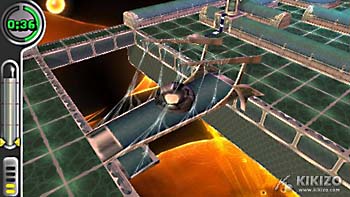Archer Maclean's Mercury
"Let me welcome you ladies and gentlemen. I would like to say hello. Are you ready for some entertainment?" Oops, wrong Mercury; we're reviewing the PSP game...
| Version PSP | Developer Awesome Studios | Publisher Ignition Entertainment | Genre Puzzle |
||||
There are many famous things with the name of Mercury; Freddie Mercury, Mercury Rev, a NASA space program, the messenger of the Roman gods and the planet named after him. Now to add to the list, we have a game for the PSP. The name of the game is derived from the mercury element (Hg 80), the stuff you find in old thermometers and tooth fillings, nastily toxic if ingested but still mesmerising to look at.

And the mercury in this game is no less attention-grabbing than the real thing, and not just in the looks department. The movement of the in-game mercury acts unerringly similar to how you would expect actual mercury to move, if that is you were able to control it in the same way. It splits and joins, drips over ledges, compresses and elongates with such naturalistic movement that it's hard to believe all you're seeing is polygons on a screen.
Still, this is a videogame, and can therefore do things that real life cannot. The things that make the game are not simply the animated mercury itself, but also the obstacles, traps and other elements that make up the courses that the game consists of. There are, amongst many other things, conveyor belts, vacuum pipes, teleporters and Mercoids (small mercury eating Pac-Man-alikes). To describe Mercury in terms of other games, it's an amalgamation (ho-hum) of Marble Madness and Super Monkey Ball, but with less marbles and no monkeys. If ever there were reason to score a game lower, it would be for a lack of monkeys, but we'll let Mercury off in this case.
Therefore the object of the game is to move the mercury blob around these obstacles to attain the goal of each level. These goals include races (start to finish), percentages (get a set amount of the blob to the goal) and tasks (activate a number of beacons dotted around the level), and all within a set time limit. There are also combo levels which are a mixture of these three basic tasks, and lastly boss levels which are massive, sprawling levels filled with tough challenges.
Some of these level tasks may also involve the use of a 'paint shop' to change the colour of the mercury blob. More fiendish levels start out with multiple, smaller blobs spread out over the level which must be joined together, sometimes even mixing colours together to activate certain switches. It is with the colour that lies the biggest issue with the visual design, as differentiating between the metallic hues can be difficult (particular for those with colour-blindness), but the layout of the levels suggests the order in which to tackle obstacles, so even this is not a particularly large problem.
Now spread those level types out over 6 themed worlds, 12 levels on each, and you've got yourself a total of 72 levels. That may seem a lot to begin with, but the game is so drawing that it won't be long before you've seen them all. At least that is if the increasing difficulty of the game doesn't stop you in your tracks, which is a distinct possibility. Puzzle games are renowned for being a bit tricky and Mercury is thankfully no exception, as they're supposed to be challenging, supposed to tax your brain as well as your thumbs. Besides, even if you do see all of those levels, the task then is to top the scoreboard on each, as doing so will unlock more levels, hurrah. It's safe to say though, that if you don't have the persistence to unlock these bonus levels, then neither will you have the patience to finish them.
To like Mercury you do need to like your puzzle games, have dextrous thumbs and the endurance to repeat levels enough to attain the highest possible score, and so far you should have a good enough idea if this is the game for you. It is difficult, and occasionally frustrating with it, but never unfair, much as we would hope any platform/puzzler to be; but what of the rest of the games' elements. Well we've already touched upon the eye-candy that is the mercury blob itself, and indeed as a whole this is one pretty game; abstract for sure, but very well designed to the point where you know what everything is for just by looking at it.
Thankfully the visuals are backed up by some perfectly matched sound effects, from the glooping noise of joining blobs of mercury, to the sucking vacuums and munching Mercoids. Even the background music, if you're not too busy focussing on actually playing, is nice enough. The overall presentation can seem a little sparse though, save for the Stargate-esque hub area, but that's no great shakes seeing how the majority of time is spent within (and repeating, for high scores) particular worlds and levels.
There are only a few game genres that seem to imbue the feeling of being 'in the zone' - 2D shooters and rhythm-action games - and puzzle games can be included in these. Yet it is probably more accurate to say with Mercury, that instead of being 'in the zone' you're 'on the blob'. Perhaps cruder too; but no less fun for it.
| ||||||||||||
|

















 Satoru Iwata Video Interview - the late Nintendo president spoke with Kikizo in 2004 as 'Nintendo Revolution' loomed.
Satoru Iwata Video Interview - the late Nintendo president spoke with Kikizo in 2004 as 'Nintendo Revolution' loomed. Kaz Hirai Video Interview - the first of Kikizo's interviews with the man who went on to become global head of Sony.
Kaz Hirai Video Interview - the first of Kikizo's interviews with the man who went on to become global head of Sony. Ed Fries Video Interview - one of Xbox's founders discusses an epic journey from Excel to Xbox.
Ed Fries Video Interview - one of Xbox's founders discusses an epic journey from Excel to Xbox. Yu Suzuki, the Kikizo Interview - we spend time with one of gaming's most revered creators.
Yu Suzuki, the Kikizo Interview - we spend time with one of gaming's most revered creators. Tetris - The Making of an Icon: Alexey Pajitnov and Henk Rogers reveal the fascinating story behind Tetris
Tetris - The Making of an Icon: Alexey Pajitnov and Henk Rogers reveal the fascinating story behind Tetris Rare founders, Chris and Tim Stamper - their only interview? Genuinely 'rare' sit down with founders of the legendary studio.
Rare founders, Chris and Tim Stamper - their only interview? Genuinely 'rare' sit down with founders of the legendary studio. The History of First-Person Shooters - a retrospective, from Maze War to Modern Warfare
The History of First-Person Shooters - a retrospective, from Maze War to Modern Warfare